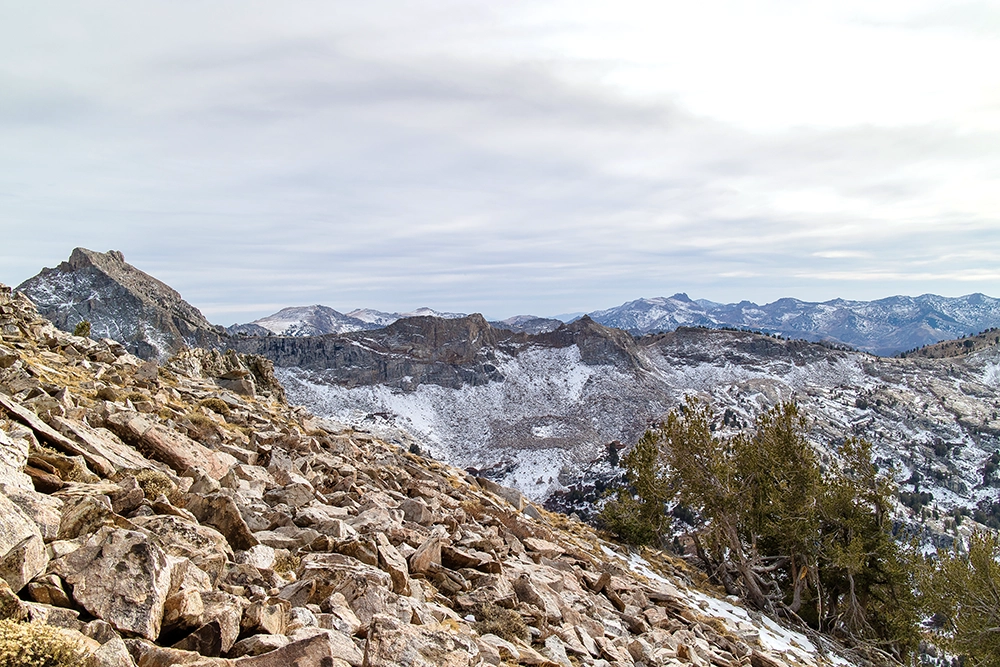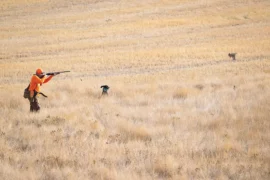From our September/October 2025 Issue
I was craving adventure in Nevada. Two weeks’ worth. I needed to test modifications to my travel rig and an “A-frame” camper I had been altering for remote forays. Birds beckoned—chukar, blue grouse (I’m not trendy enough to say “duskies”) and perhaps Hungarian partridge. Himalayan snowcock season was growing short. I had access to the first three species at home in Wyoming, but there’s nothing like Nevada!
The plan was solid. Then strength-sapping illness struck—not something I wanted to battle in the mountains of Nevada. I was delayed for 10 days. I needed more recovery time, but the weather window for my favorite snowcock area was about to slam shut. So I finished prepping the truck and camper and loaded the supplies, and my Border collie Tucker and I departed early in the morning.
The truck ran great, and my towing mileage turned out to be phenomenal. It was an easy day—about 500 miles of dry roads and nice weather. I needed an easy day. By the time darkness set in, I was camped along a burbling stream in Nevada’s Ruby Mountains, a place most familiar and comforting.
The next morning Tucker ravaged his kibble in seconds. I, on the other hand, still felt like I’d wrestled a dump truck and lost. With only two good-weather days predicted before five days of snow, I loaded my pack and chose my traditional snowcock gun: a Lefever 12-gauge.
I looked at Tucker. I looked up at the fading stars. Then I groaned forward into the mountains.
That day would be one of tests. For me, it would be a measure of endurance. For Tucker, it would be to see if he could take over the reins as snowcock dog, a role my other Border collie, Rusty, had filled until his recent retirement. My faith in Tucker exceeded my confidence in myself. Several hours later, looking down over towering canyon walls, that hadn’t changed.
Tucker turned birdy as soon as we angled onto the first good snowcock slope. With a burglar-alarm chorus, five snowcock flushed more than 100 yards below. Then two more launched to my right, well within range. No bang. I had failed to get the safety all the way off—a result of severe fatigue. Then the hillside erupted with blue grouse. Redemption. One succumbed at the gun’s report. Somewhere far below an eighth snowcock piped the “see ya later” song.
All of the snowcock landed on a massive outcropping on the far side of the valley, just as they had done in years past. I’d played this game before, and when we got within 150 yards of the birds, Tuvker caught scent. But the stalk ended when I watched the snowcock depart from the far side of a crevasse just out of range.
An opportunity came on a different covey following a climb up a chute between cliffs. When I peeked over the final boulder between us, my heart jumped. Two birds were hopping up a rock wall within 50 yards. The Lefever had taken snowcock well beyond that range. I shot behind the first bird as it bailed off, but then 15 more erupted in tight formation—only the second time I’d seen snowcock clustered so close together. For a split second I thought a shot could bring down my limit of two . . . at which point I had a mental meltdown and turned into Captain Airball.
Tucker and I searched fruitlessly for another two hours before grudgingly reversing course. Thankfully, on the way back to camp I shot two more blue grouse—a true blessing, seeing as I was depending on my own ability to provide meat. When I travel to hunt, I generally live on birds and pasta. The need to harvest game puts a new perspective on things, adding to both the pressure and the reward.
The next morning I decided to try a different canyon and a different gun. I hadn’t shot the Lefever well, so I took out my British 16, giving up 20 yards of reach in the name of hopefully hitting something. By day’s end Tucker had found many blue grouse and a trio of snowcock. Three of the grouse and one of the snowcock made the journey back to camp. My mood was jubilant—a triumphant blend of gratitude, amazement and pure exhaustion. More important, Tucker had provided advance notice of every snowcock encounter for the second day in a row. He had passed his test with flying colors.
On day three I fly-fished for a half-hour and then broke camp. When I was ready to depart, I turned the key in the truck . . . . Nothing. Dead battery. I’d run the inverter too long to power the boot dryer, camera charger and so on. Luckily I was able to use the camper battery to jump the truck battery. The first snowflakes were touching down as I pulled out for the southern, less-snowy end of the mountain range.
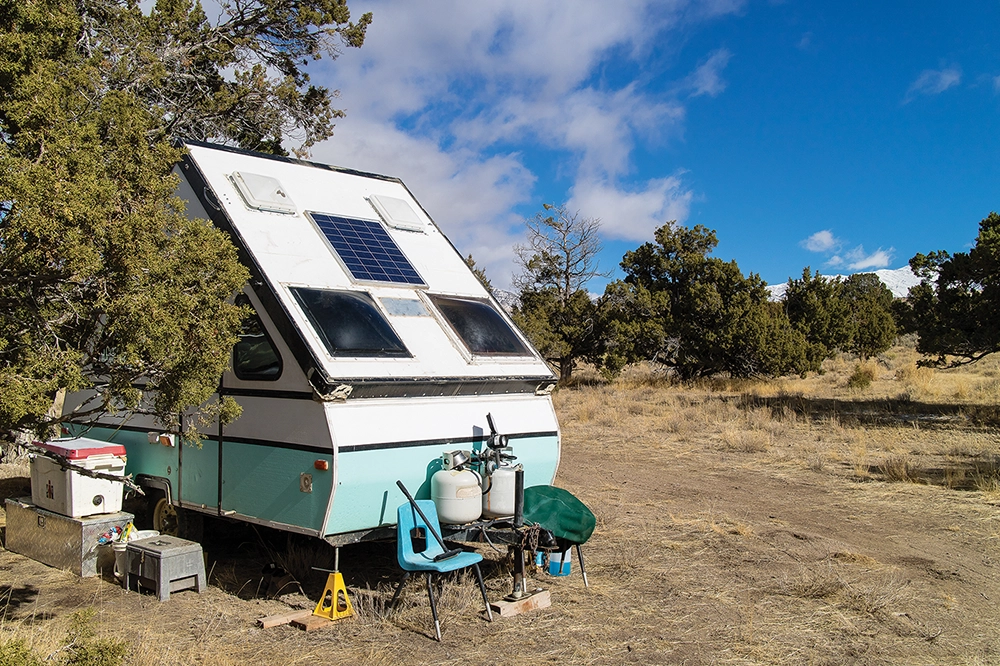
Two hours later I set up near where my friend Brant Didden and I had camped the previous year. The spot allowed access to a variety of four-wheel-drive trails, some leading as high as 10,600 feet. As I organized camp, I noticed some Hungarian patridge feathers. This meant two things: that the Huns we’d suspected lived in the area really did, and that other hunters had already been there. Adding Huns to the list of possible quarry—which already included chukar, blue grouse and snowcock—picked up my spirits.
The fourth morning I was feeling better, and the peaks and their snowcock were calling. Though I attempted to answer, thick freezing fog above 9,800 feet along with high winds and brutal cold drove me back down to go after chukar.
The decision proved worthwhile. In the following days I discovered the wealth of chukar that Nevada officials had been bragging about. Oddly, I saw no other bird hunters. This allowed me freedom to explore, and I found the red-legged bandits at elevations from 6,500 to nearly 11,000 feet. As is typical with chukar, the most productive slope, hands down, was the steepest and most punishing. But when a gathering of nearly 80 birds erupted over my little white dog, the suffering seemed justifiable.
Hunting these chukar differed from hunting those in Wyoming. In Wyoming we hunt a cheatgrass-sage mix or go without. In Nevada there are a variety of forage grasses. This complicates locating birds based on food, but typical chukar preferences for brush-grass mixtures and topography hold true. Many coveys live without readily available water, digging for moisture-rich root bulbs as needed. The diggings are usually smaller than a coffee cup and sometimes cover quite a bit of ground. This knowledge combined with Tucker’s nose kept our chukar action steady.
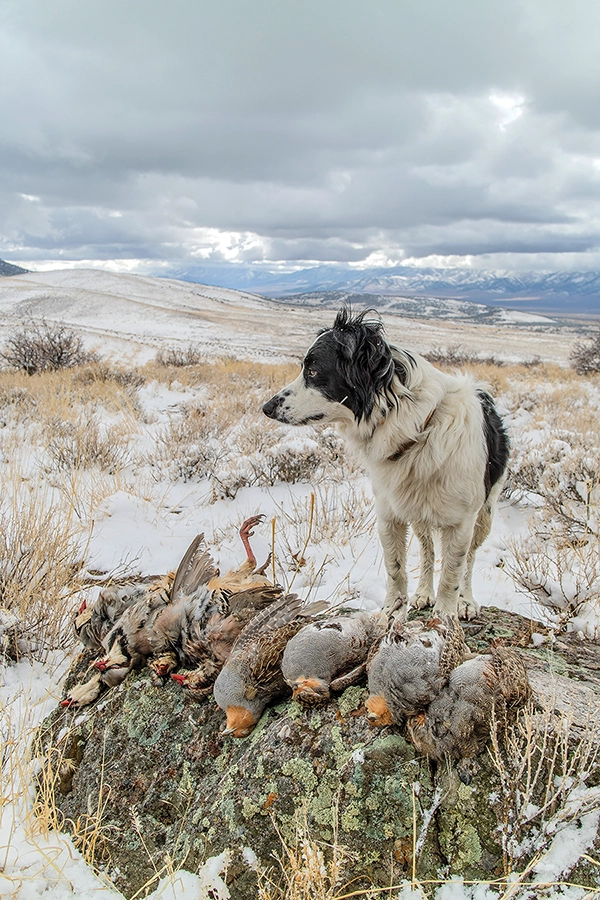
Day five was a marathon. In the morning Tucker put me on a surprising number of chukar. Rather than return to camp to rest, I couldn’t resist climbing upward as the clouds lifted. The previous year a great many grouse had occupied the high country along with a small band of snowcock. As it turned out, however, no two years are the same, and the pair of blue grouse I carried back to the truck were hard earned. The snowcock had evidently moved off for winter.
In the following days Halloween came and went, and the Rubys continued making their own weather as adjacent mountain ranges basked in sunshine. I was able to grow stronger, thanks in part to a steady diet of chukar and blue grouse.
Each day included new lessons, like how with properly reduced air pressure in its tires, a ’97 F-150 can climb mining trails steep enough to unweight the front suspension. And how an 11,000-foot peak that once held snowcock can instead become productive for chukar and blue grouse.
Eventually snow arrived, and it seemed to settle in with a permanence that indicated winter had come to he high country. As the white stuff fell, we found Huns low where the mountains become valleys—country where ridge fingers trickle out into sage prairie. Another mystery solved. Still, there was one nagging question: Where did the snowcock above camp spend the winter months? After three years of wondering, the answer came on day 12, the last of the trip.
I had harbored no delusions about hunting snowcock that day—simply planning a morning of chasing chukar followed by a restful afternoon in camp. The chukar turned out to be a slam dunk. Tucker found new birds that held well, and I managed to shoot them when they flew. Riding high on success—and the fact that it was only 9 AM—I ventured higher for blue grouse.
At about 10,000 feet I could drive no farther. The snow was too deep and the climb too steep. I found a safe place to park, and then set out.
One thing led to another, and I found myself at the edge of the snowcock zone in cold temperatures and stiff winds—wishing I’d brought a jacket and lunch. Suddenly I cut fresh snowcock tracks, and Tucker was pulling hot scent. I hoped to ambush the bird at the ridgeline but found where it had sailed across to a rock fortress that had kicked my butt in the past. While backtracking to the shadowy side of the mountain, I watched two snowcock sail out far below after Tucker had scented them.
Now what? I tried Brant Didden’s trick of the ascending whistle. Birds over at the “fortress” answered back with the whole angel-chorus routine. Against my better judgement, I attempted a stalk. Eventually I ran out of approach options and had to abandon the effort. The fortress had beaten me again. Still, it was very satisfying to have finally solved the mystery. All of my prior encounters here had taken place after I’d chased birds into the location. I’d never realized that they might choose it as more than just an escape route.
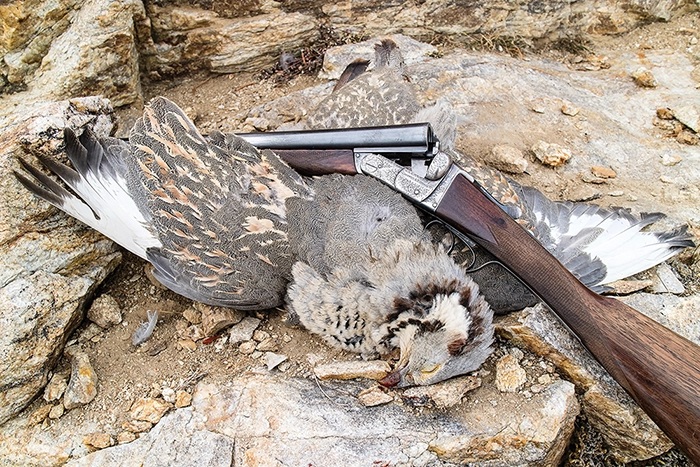
Tucker and I made it to the truck just as shadows were engulfing the valley. I was grateful that the seat and steering wheel were still warm from the sun. The six chukar I had taken in the morning were already partially frozen.
As I drove back, the deer hunters in the next camp flagged me down. I promised to jump their pickup before leaving the following morning. Low-battery issues had been a theme this trip . . . .
Two weeks on the road, 12 days of hunting—just Tucker and me. That’s a lot while recovering from an illness, especially in Nevada’s grueling terrain. I’d bitten off plenty and hadn’t known if I’d be able to chew it. In truth, I would have waited longer if weather threats hadn’t loomed. Such challenges have a way of defining character and honing resolve. As it turns out, my trip to Nevada proved to be an exercise in healing in more ways than one.
Read our Newsletter
Stay connected to the best of wingshooting & fine guns with additional free content, special offers and promotions.

